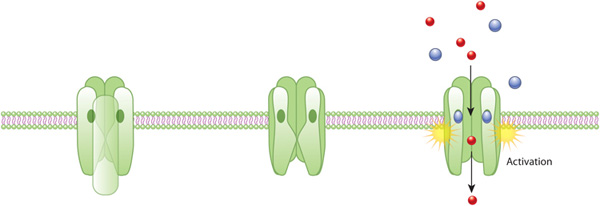How do cells generate an electrochemical gradient?
1 Answer
Cells generate an electrochemical gradient by using ion channels to pass ions from one side of the cell membrane to the other.
Neurons and muscle cells maintain different concentrations of ions (e.g., Na⁺, K⁺, Cl⁻, Ca²⁺) in the cytoplasm than in the extracellular environment. These concentration differences create a small electrical potential across the plasma membrane.
The plasma membrane contains Ion channel receptors — clusters of proteins arranged to form a channel from one side of the membrane to the other. The ion channels open and close in response to chemical signals.
In the figure below, an acetylcholine receptor (green) forms an ion channel in the membrane. It allows soluble materials to travel across the plasma membrane when open.
When no external signal is present, the channel is closed (centre). When acetylcholine molecules (blue) bind to the receptor, this triggers a conformational change that opens the channel and allows ions (red) to flow into the cell.


